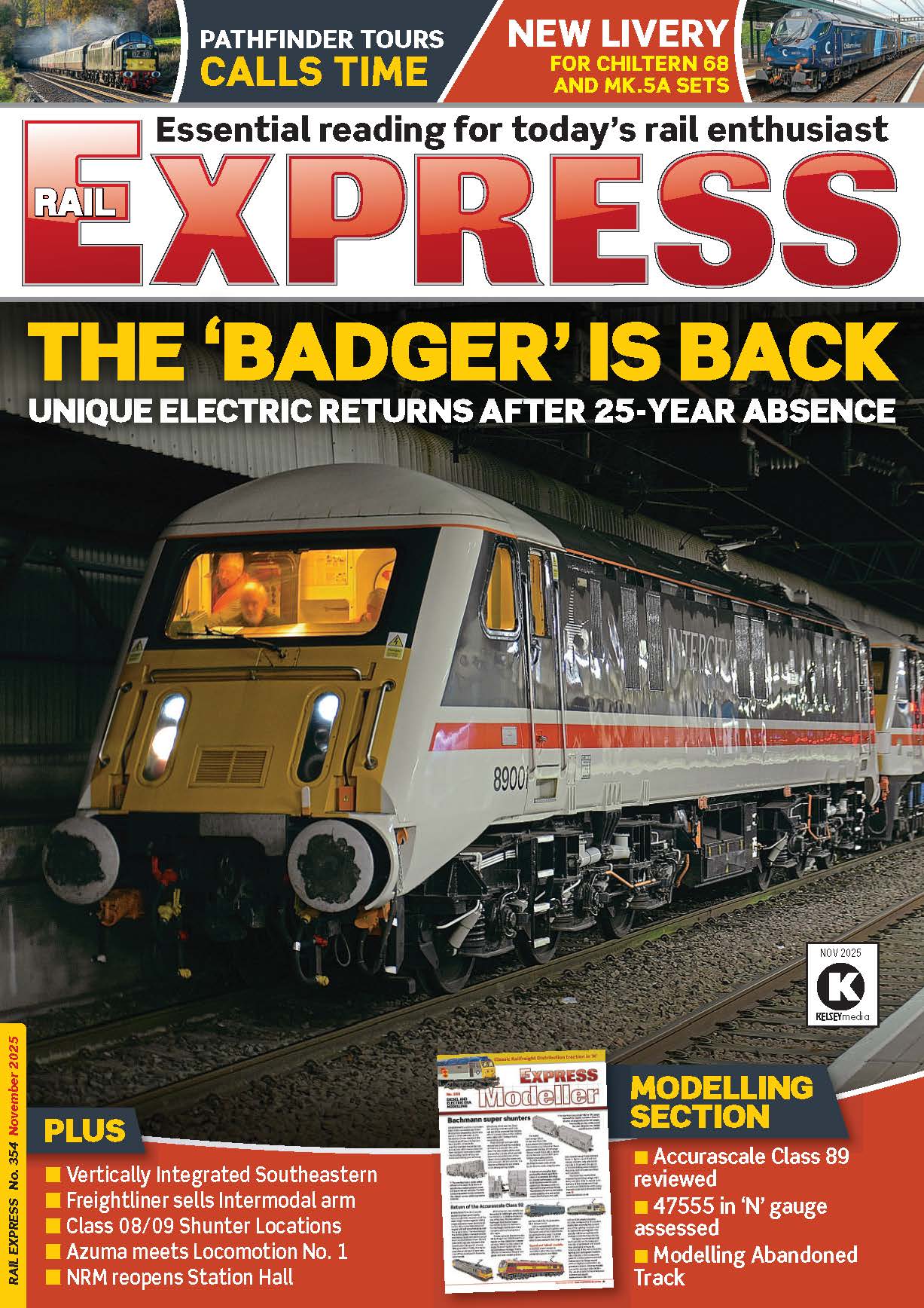Trials using a battery-powered Class 230 on the Greenford branch are under way. Richard Clinnick reports from the formal launch of the project and speaks to those involved in the project.
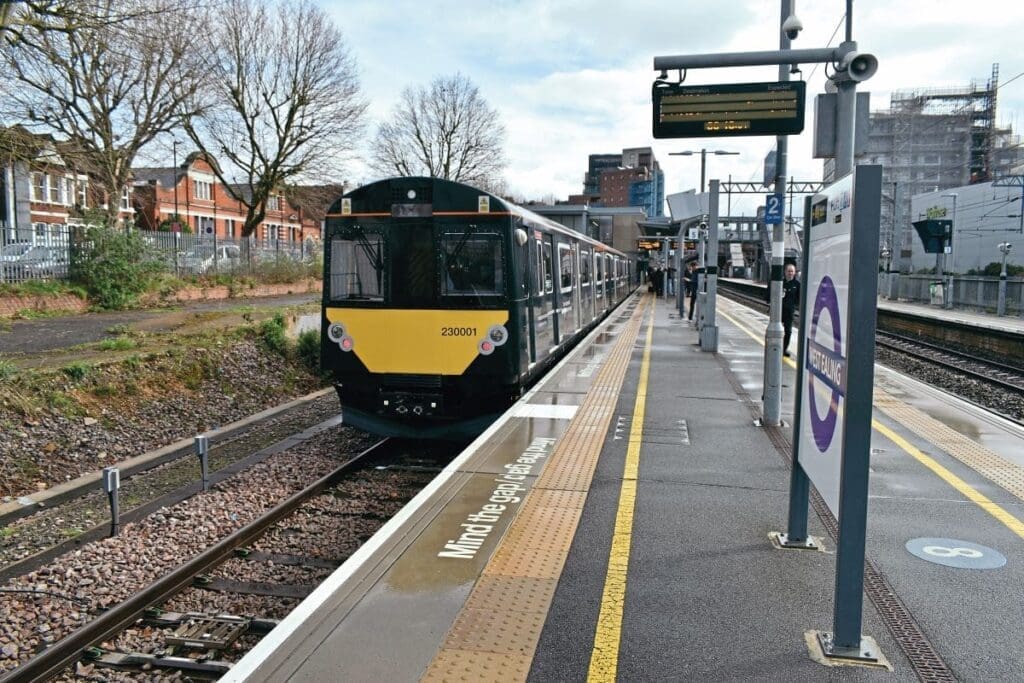
This article first appeared in the May 2024 issue of Rail Express. Keep up with all the latest news by subscribing to the magazine today.
The issue of traction power for trains, both existing and new-build, is one that is set to dominate discussions for some time.
Enjoy more Rail Express Magazine reading every month.
Click here to subscribe & save.
In many cases, electric trains are the preferred choice, however this is not always possible. A lack of coherent electrification strategy by the Department for Transport (DfT), combined with the costs surrounding such schemes, means operators, manufacturers and rolling stock leasing companies, as well as infrastructure suppliers, must look to other options to power trains.
This situation is further exacerbated by the need to decarbonise the country’s railway system by the 2050 deadline set by the Government. But then this is the same Government that has increasingly turned off the funding tap for the railway and, only recently, published a letter detailing planned orders for Chiltern Railways, Northern, Southeastern and TransPennine Express without confirming any progress (RE335).
Great Western Railway has a large fleet of Sprinters and Turbos dating from the mid-1980s (24 Class 150/2s, 18 Class 158s in two and three-car formations, 36 Class 165s in two and three-car formations and 21 Class 166s) and yet the letter stated that their replacement was an aspiration and was not included in the main round of proposed orders! This means that the ‘150s’ will easily pass their 40th anniversary in traffic and could be forced to carry even more passengers when the five High Speed Train Castle sets largely confined to the Plymouth-Penzance route are withdrawn next year.
For the time being, if GWR wants to increase capacity on its fleet it will need to look to cast-offs from other regions. As the operator’s managing director Mark Hopwood told Rail Express in an exclusive interview in November 2023: “I think a lot of people, politically, get obsessed with the sort of north south divide and that actually, the south west often gets forgotten.” That certainly looks to be the case for new trains for the rural routes.
But GWR has been looking at ways to circumnavigate these problems. Figures published by the Office of Rail and Road (ORR) last autumn showed that of GWR’s 1087 vehicles, some 12% were electric, 22% were diesel, 10% were locomotive-hauled and 56% were bi-mode. The average age of GWR’s fleet was 14.9 years, placing it 14th in the overall table of oldest trains in Britain but failing to mention that while the Hitachi Class 80x fleets and Class 387 Electrostars are both fairly young, the Class 15x and ‘16x’ fleets are much older. Certainly Mr Hopwood conceded to RE332 that: “We’ve got quite a lot of trains that are approaching the point where they’ll need replacement.”
Enter the Class 230 now undergoing trials on the 2.4-mile-long West Ealing-Greenford branch. Back in early 2022 it was announced that, with funding from the DfT, GWR would operate a trial using a Vivarail ‘230’. The unit, No. 230001, was to be prepared ahead of the trial, however, this was put at risk when Vivarail went bust at the end of 2022. To save the trial, GWR bought not only that ‘230’ but also many stored D-Train vehicles at Long Marston, the intellectual property regarding the fast-charging system developed by Vivarail, and agreed to take on staff who had been working on the project.
GWR also subsequently bought the three Class 230s that had been used by London Northwestern Railway on the Marston Vale line between Bedford and Bletchley, but which had been withdrawn after Vivarail’s demise meant that they could not be maintained.
With the project able to continue, testing of No. 230001, now in GWR colours and named Viva Venturer, was able to commence initially at Long Marston, although it ventured onto the national network.
On February 14, the ‘230’ set the record for the longest distance covered without a charge when it ran for 86 miles; the previous record being 84 miles completed by a Stadler Class 777 under test conditions. Some 1500 hours of testing had also been completed at Long Marston before the ‘230’ headed to its new home at Reading on February 16. Running under its own power, the ‘230’ completed 70 miles on the national network and even then, only used 45% of its battery capacity.
Ahead of the official launch of tests on the Greenford branch, GWR held an event with invited guests able to take a trip on the ‘230’. Rail Express attended the event where Mr Hopwood said of the three-car battery unit’s performance: “If I’m honest, the last few weeks have actually exceeded our expectations. We’ll be working very hard to make sure that the trial delivers what we’ve said it will and we’ll be obviously engaging with our colleagues in DfT and Network Rail.”
He added that innovation is really important at GWR. “People often talk to me about our brand and they say, ‘oh well you know, Great Western Railway is harking back in history’, but we’re not. Actually, we are ahead of everyone else with the technology that we have here. GWR has always had a bold and broad approach about replacing diesel trains and we’re proud to continue leading the way.
“I think research will help the industry understand what’s needed to roll this technology out. We are blessed at GWR with a number of branch lines which I think are ideal for this technology to be rolled out.”
He said that the trials will seek to judge the potential compatibility of the technology with up to six trips per day operating on the Greenford branch. “The hard work really begins as we test the performance of the technology in what’s going to be a variety of different climates and different operating conditions. I think we’ve already demonstrated with the work we’ve done that there is a place for battery train technology to decarbonise [the railway].
“Although at this stage we’re only running the train on the Greenford branch, we have done computer simulations of how this would work on things like Windsor, Bourne End, Marlow and Henley, as we believe the technology could transfer quite easily.”
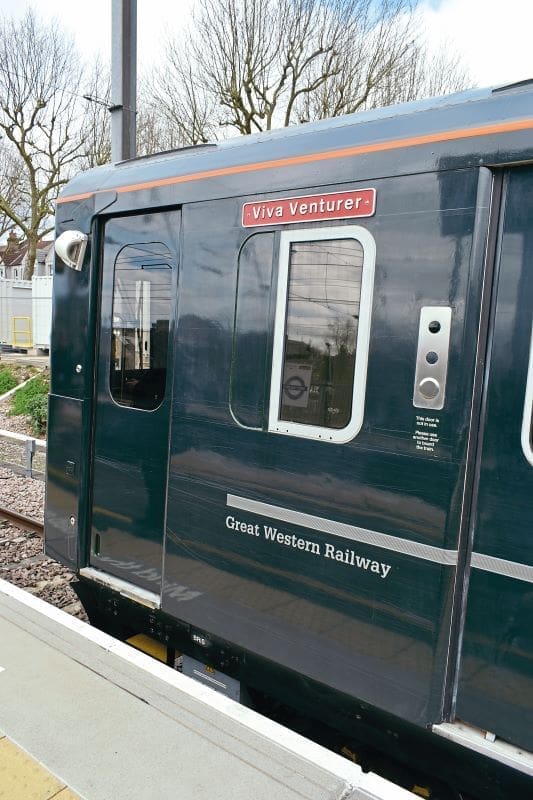
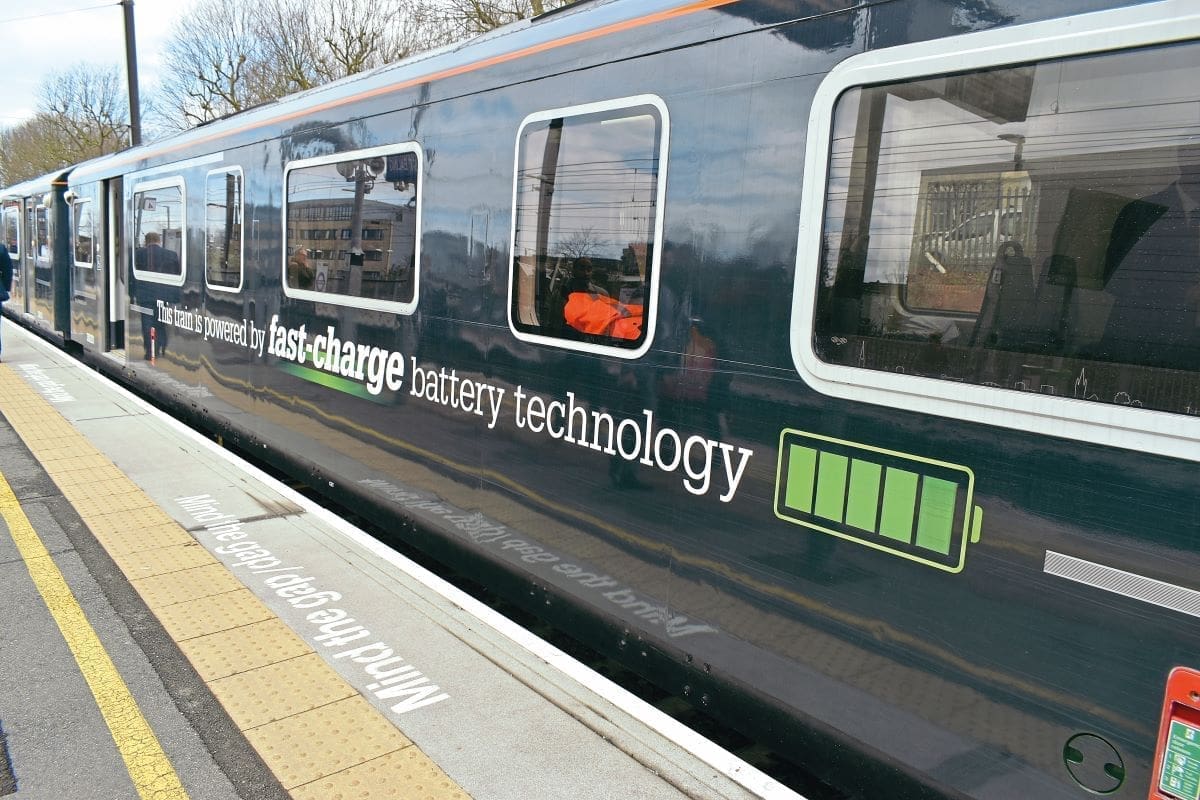
Mr Hopwood also used the launch to acknowledge the work of Adrian Shooter, the creator of Vivarail, who died in 2022.
He said: “It was Adrian’s passion for developing a fast charging system that brought us to where we are today. We originally engaged with Vivarail on this project and we recognise the great work they’ve done. We were very keen, when there were some challenges there, to work with the team to engage with the DfT to find a solution that enables us to ensure that the intellectual property and the rolling stock was protected, and that we could deliver this project.”
“We’ve also employed a fantastic team of engineers who continue to develop the system, and now we’ve got a train that can operate to at least the same timetable as the diesel train, and who knows, at some point, maybe accelerate a little bit quicker in the timetable as well, but we don’t have the associated emissions or air quality issues.”
Rail minister Huw Merriman was unable to attend the event but did speak via a pre-recorded video message. He said: “This trial proves the potential for battery technology to accelerate decarbonisation of our railway and deliver real environmental benefits through the removal of harmful diesel emissions at pace. This trial will provide invaluable data to help us understand if battery technology can be used on other parts of the network such as those places where electrification is difficult due to structural or environmental restrictions, or doesn’t provide the best value for money. I know the Great Western team are already looking at the other branch lines on their network and I look forward to discussing the opportunities with them soon.”
Speaking to Rail Express on February 29, GWR engineering director Dr Simon Green explained: “The Greenford branch was chosen because it is a two-track railway so we can effectively have two trains in action and we can get confidence in how the battery train is performing. And, if there is a problem, the passenger service is not affected.”
Initially the ‘230’ will operate without passengers and will be crewed by RailAdventure, which drove the unit from Long Marston to Reading. Longer-term the aspiration is for it to carry passengers, although negotiations need to be concluded with the relevant unions before training can start.
“Then, at some point we will get to a position where we then switch over into passenger service and take the ‘165’ away and use the ‘230’. It’s not an absolute requirement of the trial, we could do it entirely in ‘shadow mode’, but that’s not what we want to do.”
THE TRAIN
The three-car battery unit, No. 230001Viva Venturer, was rebuilt from redundant London Underground D-Stock by Vivarail. Driving Motor Standard (DMS) vehicles Nos. 300001 and 300101 were rebuilt from Nos. 7058 and 7511 respectively, while Trailer Standard No. 300201 was rebuilt from No. 17058.
Each DMS is fitted with three 84kWh Hoppecke batteries.
Internally, the ‘230’ features a modern interior, with 28 seats inNo. 300001 and 32 in No. 300101, while the TS features an accessible toilet and wheelchair space, as well as 34 seats including bench seating. There are also USB ports and sockets.
When travelling on the ‘230’, specialist data shown to guests showed that four of the six batteries were being used when the train travelled. These batteries are fitted to rafts with each raft weighing 1.7 tonnes. In total, the train has 504kWH (675hp).
The operator believes that while batteries offer highly-usable energy storage solutions, until now, their use in providing tractive power has been restricted by range. However, with a round-trip on the Greenford branch being less than five miles, range anxiety is not expected to be a concern. But there are factors that must be taken into account when it comes to power being drained from the battery. The exact range of a battery-powered train is dependent on many factors including the installed battery capacity and chemistry, hotel power for lights, heating and cooling, the number of stations stops, gradients, maximum running speed and passenger loading. Because these vary on a route-by-route basis, the range is expected to vary depending upon which service the train is employed on.

One example is the weather. The energy required to heat the train will reduce the energy available for traction. GWR said that this trial will quantify the effect of cold weather across a full year through all four seasons. Dr Green said: “We’re coming out of winter into spring and in terms of performance spring’s usually a pretty good time of the year. There aren’t too many adverse conditions, but as we get into summer and it gets hot you get to see how the batteries perform. Then as we pass through autumn into winter, we want to see how they perform in the cold. Then we’ll come back into the spring and the official trial period will end and we’ll then have a better understanding of how this sort of technology works.
“What we would hope to see in the 12 months is a much wider range of conditions and to understand how the train performs in those circumstances and specifically how the batteries perform.”
The ‘230’ is fitted with charging shoes and each set is rated for up to 1MW charging power, meaning that the two sets could deliver real-life range to the train at over 4.6 miles of range for every minute charged. The Greenford branch has a maximum speed of 40mph so the train is only charged at 700kW as the fast-charge system can be sized appropriately for its location to maximise cost effectiveness.
GWR said that looking beyond the trial it is hoped that the technology could one day see battery-powered trains operating across the country on more than 80 branch lines.
The operator said that the fast charge technology is small in size and complexity and uses off-the-shelf technology in key areas, including trackside battery energy storage systems, while the speed of its installation is another benefit as track works only takes hours. The fast-charge system also does not require the rails to be live all the time, indeed they only go live when the train covers them, while the system has been developed to fit into any suitable diesel train with the shoegear designed to be ultra-compact and able to fit into a space barely bigger than a shoebox.
Maintenance will be carried out at Reading, Dr Green confirmed, but it is planned that the unit will return there roughly once a month and will remain outbased at West Ealing.

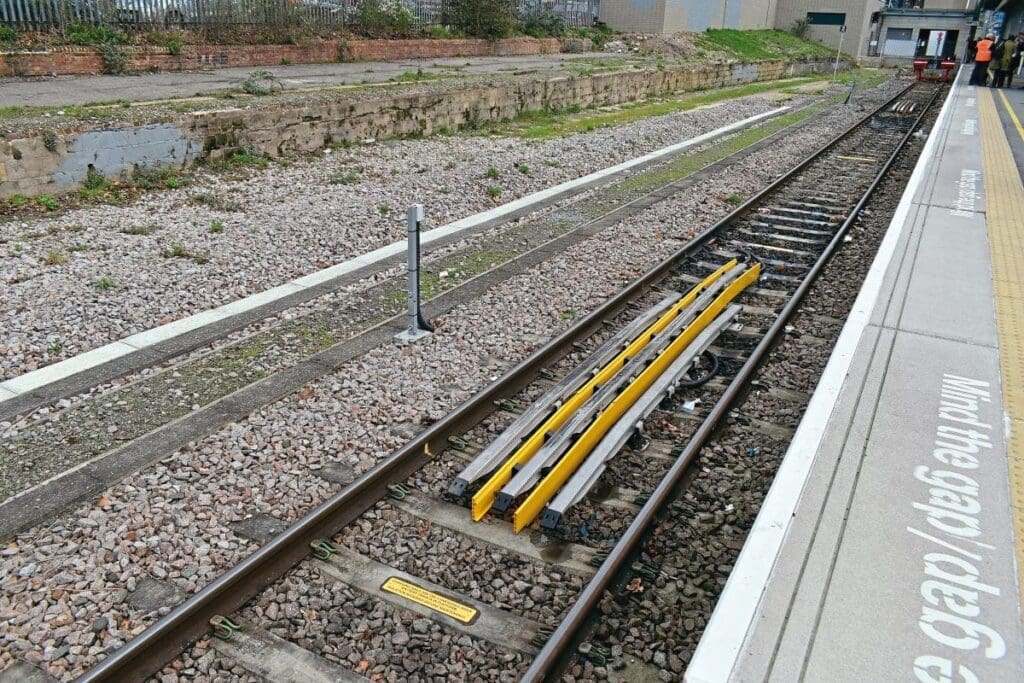
HOW IT WORKS
Charging rails are installed at a chosen station. For the GWR trial they are located at West Ealing in the bay platform. These are positioned within the rails and are easy to install without the need for lengthy engineering possessions which would likely cause disruption.
As the train approaches the station the sensors fitted to the train and trackside prime the fast-charge system ahead of charging. Then, as the train approaches the fast-charge rails the electrical contact shoes lower, ready for charging to begin. Once lowered, the charging shoes will then ride along the fast-charge rails to make a solid contact.
Once the fast-charge begins, the six batteries on board the train are charged at a rate of up to 2 Megawatts from the trackside battery bank. An air-cooling system helps maintain optimum performance. The trackside battery bank is trickle charged from the National Grid, meaning no spikes in demand on the grid and no large electrical infrastructure is required to be installed at stations along the route.
GWR said that the fast-charge system uses a trackside battery energy storage unit which has the ability to be hooked up to existing technologies including renewable energy supplies such as wind farms and solar panels, as well as off-peak energy supply, and integration, with electric vehicle charging. Charging at West Ealing will take 3½ minutes.

THE FUTURE
Great Western Railway has confirmed that the trial will last for 12 months and will test the capability and viability of the technology. It is keen to point out that the Class 230 is already approved and proven. As this issue of Rail Express went to press there were currently no plans to use the ‘230’ beyond the trial.
There have been independent assessments conducted that have already identified a place for the technology in the decarbonisation of the network, with the Rail Safety and Standard Board and Great British Railways Transition Team involved in this work.
GWR has several routes it believes the technology could be used, with the Thames Valley branches prime candidates. The operator said that switching to the fast-charge technology on the four Thames Valley branches could reduce GWR’s emissions by over 1700 tonnes of CO2e per year.
No. 230001 has a top speed of 60mph, however its superior acceleration from electric power enables it to match, or even improve, station-to-station running times of similar diesel trains which have a higher top speed but a lower rate of acceleration. GWR added that the introduction of battery electric multiple units (BEMUs) offers the benefit of an electrified railway without the requirement of building the infrastructure.
However, GWR is realistic in that it does not believe that BEMUs will replace all diesel trains. “The fast-charge system brings most benefit on shorter, branch-line type routes. On longer routes, battery bi-modes, which can either take power from the 25kV overhead electrification or run on battery power alone, are currently a better solution.”
For typical branch line operation where DMUs are currently used, battery trains with fast-charge technology offer reduced operating costs when considering associated infrastructure, fuel and maintenance costs according to a study on the use of fuel cells and hydrogen in the railway environment conducted by the EUa Shift2Rail Joint Undertaking back in 2019.
Dr Green said: “There is a wider question in the round whether [battery technology] is something that we want to do, but actually we know it can be done. At the moment we don’t perceive any technical reason [why it could not be used] but the purpose of running a trial is to find that technical reason and resolve it but, on paper right now, we could use them.”
Rail Express suggests that the branches in Devon and Cornwall could be ripe for battery trains considering that they are unlikely to ever be electrified. Dr Green replies: “The problem at St Ives is capacity in the summer, a three-car train doesn’t cut it. We use four-car Class 150s and they are full and standing. That is not to say that these trains could not do that, but that is not part of the trial. And then some of the Cornish branches are trickier because of their topology and, again, we have looked at that and there is always an engineering solution but it is going to depend on how many fast charge points you want.
“A lot of the Thames Valley branches are doable with a charger at one location on the branch, whereas some of the Cornish ones might require a charger at either end, and you have got to have enough dwell time to charge the batteries to be able to get back. So, at this stage, it is not planned to take these trains to Cornwall, but that doesn’t mean to say that might not be a future option, depending on what happens with the trial.
“We have to go back to the fact that this is a trial, it is not necessarily intended to be a widespread fleet introduction at this stage.”
These trials will prove fascinating as to the future decisions for rolling stock. Hydrogen and battery power is being used in mainland Europe and further afield, discontinuous electrification is another possibility, but GWR’s use of fast charge technology on this trial could offer a tantalising glimpse into the future of its new train fleet.


